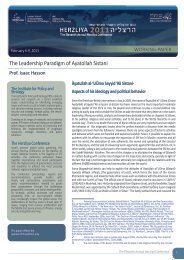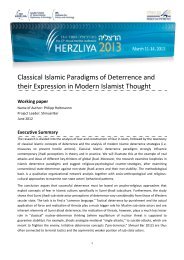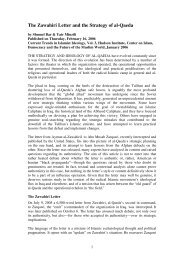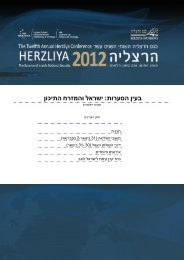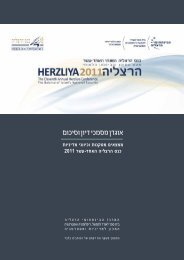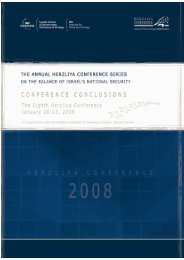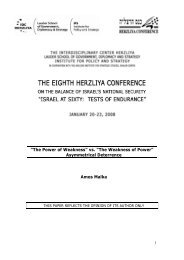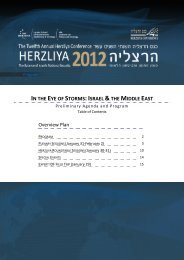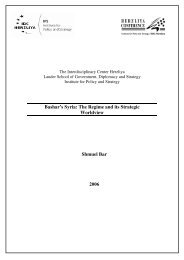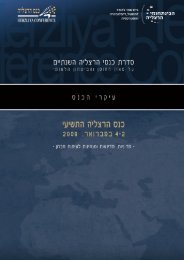<strong>Iran</strong>: <strong>Cultural</strong> <strong>Values</strong>, <strong>Self</strong>-<strong>images</strong> <strong>and</strong> Negotiating <strong>Behavior</strong>towards government as an exploiting enemy; a belief that nothing can change for thebetter. 42 As a field study, Gastil’s research leaves much to be desired; however, hisquestionnaire reflected a subject that was, <strong>and</strong> is, central to a common <strong>Iran</strong>ianworldview.According to many observers, the <strong>Iran</strong>ian is acculturated to expect the worse offate, <strong>and</strong> even worse of people who have achieved high office. 43 The game of life, inPersian eyes, has been likened to “a game of hazard, where incalculable chances,good <strong>and</strong> bad, emerge <strong>and</strong> disappear, like bubbles on the surface of the water. There isno meaning whatever in this play, but he who wants to incur the risk may try to avertthe evil <strong>and</strong> to seize the favorable opportunity.” 44 Many observers of <strong>Iran</strong>ian history<strong>and</strong> society have indicated the assumption of extreme uncertainty in the course ofhuman affairs: frequent changes of ruling powers or dynasties, reversal of fortunes ofelites, <strong>and</strong> the lack of certainty that a person’s wealth will be inherited by his children<strong>and</strong> gr<strong>and</strong>children have been noted as primary elements of the <strong>Iran</strong>ian psyche. 45 Theelement of chance is paramount, <strong>and</strong> the skill of the player is employed in order tomaximize the advantage from good throws of the dice, <strong>and</strong> to minimize the damage<strong>and</strong> future risk resulting from bad throws. In practice, he achieves these ends bycunning, shrewdness, positive opportunism, <strong>and</strong> willingness to engage in the game,i.e., to take well-calculated risks for gain. Vaqi’bini (realism) is a necessary conditionfor survival.Many observers over the centuries have even attributed Persian military failures tothe inherent mistrust <strong>and</strong> incapability for teamwork 46 engendered by the hyperindividualismof Persian generals. It has been claimed that even the <strong>Iran</strong>ian criminalunderground is too individualist to voluntarily organize itself as a mafia or yakuza, orto perform sophisticated crimes such as bank robberies, which call for a high level oftrust <strong>and</strong> cooperation. 47 The belief in conspiracies also engenders a perennial mutualsuspicion regarding the true intentions of others.Acceptance of Conspiracy TheoriesMistrust is intimately linked to the <strong>Iran</strong>ian proclivity towards acceptance ofconspiracy theories. 48 The interpretation of current events through the prism of thesetheories tends to create a focus on issues or facts that may seem totally irrelevant tothe uninitiated outsider. For the most part, these theories attribute the course ofcontemporary <strong>Iran</strong>ian history to devious Machiavellian-type machinations of42 Raymonds D. Gastil, “Middle Class Impediments to <strong>Iran</strong>ian Modernization,” Public OpinionQuarterly XXII.3 1958: 325-329.43 This is illustrated by the story of Mullah Nasseradin who had a dozen marbles <strong>and</strong> asked children ifthey want him to divide them among them. Upon receiving an affirmative reply, he asked whether theywant him to distribute them as God would or as man would. The children immediately preferred thedivine option, <strong>and</strong> the Mullah then gave two to one child <strong>and</strong> ten to the other…44 Haas 119. The Persian poet Omar Khayyam used the simile of polo, with the human being the poloball: Peter Avery & John Heath Stubbs (trans.), The Ruba’iyat of Omar Khayyam, (London: Penguin,1979): 92, quatrain 167.45 See Homa Katouzian, <strong>Iran</strong>ian History <strong>and</strong> Politics – The Dialectics of State <strong>and</strong> Society, (London:Routlege Curzon, 2003): 23.46 <strong>Iran</strong>ians have rarely excelled in team sports, <strong>and</strong> even use the English word team for that institution.47 Marvin Zonis, The Political Elite of <strong>Iran</strong> (Princeton: Princeton University Press, 1971): 214.48 <strong>Iran</strong>ian proverbs <strong>and</strong> adages are full of admonitions such as “under the perfect plate, there is a brokenone” or “the half empty glass is actually full (of surprises)”.12
<strong>Self</strong>-Images <strong>and</strong> Stereotypescoalitions of enemies <strong>and</strong> foreign powers envious of <strong>Iran</strong>'s riches <strong>and</strong> potential, by useof ubiquitous secret associations <strong>and</strong> intelligence organizations. These theories aretaught in schools <strong>and</strong> are widely accepted by academic circles in <strong>Iran</strong>. According to acommon <strong>Iran</strong>ian perception, conspiracies of global forces have been woven against<strong>Iran</strong> ever since the defeat of Greece in the Peloponnesian wars, with the goal ofannihilating <strong>Iran</strong>'s spiritual essence <strong>and</strong> political predominance by the Hellenization ofits culture. The tentacles of the conspiracy are international movements such asZionism, Freemasonry, Bahais, Manicheanism, 49 <strong>and</strong> even the Shiite 'Ulamathemselves (brought to power in order to plunge <strong>Iran</strong> back into backwardness). Theseforces are also said to engage in super-technological conspiracies through geneticallymodified foods. 50 Popular <strong>Iran</strong>ian conspiracy theories that color day-to-day thinkinginclude two major motifs – conspiracies by colonial powers (Great Britain, the UnitedStates); <strong>and</strong> conspiracies led by amorphous <strong>and</strong> hostile global forces or internationalmovements.Great Britain 51 is seen as almost the prime mover of <strong>Iran</strong>ian history during thenineteenth <strong>and</strong> twentieth centuries. British conspiracies are implemented throughcunning, ubiquitous economic <strong>and</strong> cultural presence, 52 patronage of the 'Ulama <strong>and</strong>the <strong>Iran</strong>ian elite, 53 <strong>and</strong> manipulation of other powers <strong>and</strong> the media (the BBC). 54Since the mid-twentieth century, the United States, primarily through the CIA, joinedthe British as “stars” of <strong>Iran</strong>ian conspiracy theories.The receptivity of <strong>Iran</strong>ians to conspiracy interpretations of events is attributed to acombination of cultural, religious, social <strong>and</strong> psychological elements. 55 On thecultural level, it is said to feed off the Zoroastrian dualistic belief in the strugglebetween good <strong>and</strong> evil (Satanic) forces in the world, in which the human individual islittle more than a pawn, <strong>and</strong> off the legitimacy of egrag-e sha-erana (poetic license orexaggeration) in normal discourse. To this, one may add Islamic <strong>and</strong> Shiite religiousconcepts such as the belief in predetermination, the inherent contradiction betweenzaher (that which appears) <strong>and</strong> baten (the inner truth), <strong>and</strong> taqiya (the principle of49 The Freemasons are considered either a tool in the h<strong>and</strong>s of the British or an extension of Israel <strong>and</strong>the Zionist movement, <strong>and</strong> are said to have control over tribal chiefs, 'Ulama, politicians, bankers, etc.The Bahai <strong>and</strong> World Jewry, or Zionism, work h<strong>and</strong>-in-h<strong>and</strong> to destroy <strong>Iran</strong>. Ehsan Yarshater (ed.)Encyclopedia <strong>Iran</strong>ica, VI (Costa Mesa, CA: Mazda Publishers):139.50 According to one persistent rumor making the rounds in <strong>Iran</strong>, Israel (famous in <strong>Iran</strong> since the days ofthe Shah for special agricultural techniques) is said to have genetically modified the egg-layingchickens in <strong>Iran</strong> as part of “genetic warfare.”51 Yarshater 139.52 A case in point is the David Reddaway affair. Reddaway, a British diplomat who had served in theembassy in Tehran, spoke fluent Persian <strong>and</strong> was married to an <strong>Iran</strong>ian. He was appointed in January2002 by the UK as ambassador to <strong>Iran</strong>, but rejected by Teheran on the grounds that he is a Jew(because his name is David) <strong>and</strong> an intelligence agent (because he speaks Persian). The rejection was,inter alia, a reflection of a genuine deep suspicion of any foreigner (especially a Briton) who has adeep knowledge of <strong>Iran</strong>.53 A well know Persian joke claims that the Mullah wear a beard in order to hide the writing "Made inEngl<strong>and</strong>" or the Union Jack under their chin. Even the Shah told the British Ambassador “if you lift upKhomeini’s beard, you will find “Made in Engl<strong>and</strong>...” Anthony Parsons, The Pride <strong>and</strong> the Fall, <strong>Iran</strong>1974-1979, (London: Jonathan Cape, 1984): x.54 The late Shah had a profound belief in the diabolical role of Western media, particularly the BBC,<strong>and</strong> frequently called the British Ambassadors to dem<strong>and</strong> that they rein in the anti-<strong>Iran</strong>ian <strong>and</strong> proclergyforces in Bush House. A. Pahlavi, Faces in the Mirror – Memoirs from Exile (New Jersey:Englewood Cliffs, 1980): 15, 199-200; Parsons 72-73.55 See the extensive analysis of the subject of conspiracy theories in Yarshater 138-147.13



